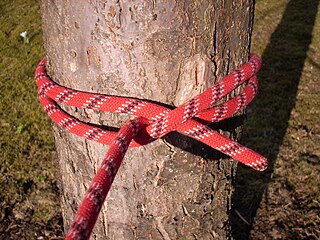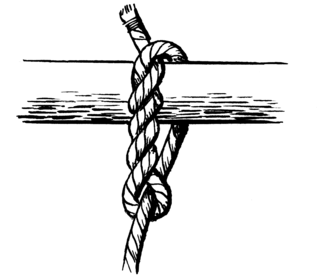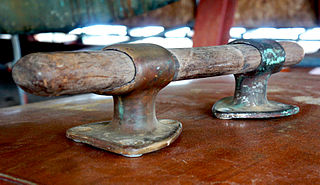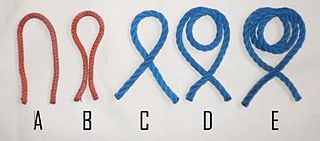
A knot is an intentional complication in cordage which may be practical or decorative, or both. Practical knots are classified by function, including hitches, bends, loop knots, and splices: a hitch fastens a rope to another object; a bend fastens two ends of a rope to each another; a loop knot is any knot creating a loop; and splice denotes any multi-strand knot, including bends and loops. A knot may also refer, in the strictest sense, to a stopper or knob at the end of a rope to keep that end from slipping through a grommet or eye. Knots have excited interest since ancient times for their practical uses, as well as their topological intricacy, studied in the area of mathematics known as knot theory.

A miller's knot is a binding knot used to secure the opening of a sack or bag. Historically, large sacks often contained grains; thus the association of these knots with the miller's trade. Several knots are known interchangeably by these three names.

The constrictor knot is one of the most effective binding knots. Simple and secure, it is a harsh knot that can be difficult or impossible to untie once tightened. It is made similarly to a clove hitch but with one end passed under the other, forming an overhand knot under a riding turn. The double constrictor knot is an even more robust variation that features two riding turns.

The clove hitch is a type of knot. Along with the bowline and the sheet bend, it is often considered one of the most important knots. A clove hitch is two successive half-hitches around an object. It is most effectively used as a crossing knot. It can be used as a binding knot, but is not particularly secure in that role. A clove hitch made around the rope's own standing part is known as either two half-hitches or buntline hitch, depending on whether the turns of the clove hitch progress away from or towards the hitched object.
Although the name clove hitch is given by Falconer in his Dictionary of 1769, the knot is much older, having been tied in ratlines at least as early as the first quarter of the sixteenth century. This is shown in early sculpture and paintings. A round turn is taken with the ratline and then a hitch is added below. The forward end is always the first to be made fast.
The difference between two half hitches and the clove hitch is that the former, after a single turn around a spar, is made fast around its own standing part, while the latter is tied directly around the spar.

A lashing is an arrangement of rope, wire, or webbing with linking device used to secure and fasten two or more items together in a somewhat rigid manner. Lashings are most commonly applied to timber poles, and are commonly associated with cargo, containerisation, the Scouting movement, and sailors.
A whipping knot or whipping is a binding of marline twine or whipcord around the end of a rope to prevent its natural tendency to fray.

The taut-line hitch is an adjustable loop knot for use on lines under tension. It is useful when the length of a line will need to be periodically adjusted in order to maintain tension. It is made by tying a rolling hitch around the standing part after passing around an anchor object. Tension is maintained by sliding the hitch to adjust the size of the loop, thus changing the effective length of the standing part without retying the knot.

The timber hitch is a knot used to attach a single length of rope to a cylindrical object. Secure while tension is maintained, it is easily untied even after heavy loading.

The artillery loop is a knot with a loop on the bight for non-critical purposes. The artillery loop must have the loop loaded or it will slip and contract easily. It is an inferior knot to the alpine butterfly knot, possibly dangerously so, in that it can be yanked out of shape and turn into a running knot or noose.

The Ashley Book of Knots is an encyclopedia of knots written and illustrated by the American sailor and artist Clifford W. Ashley. First published in 1944, it was the culmination of over 11 years of work. The book contains 3,854 numbered entries and approximately 7,000 illustrations. The entries include knot instructions, uses, and some histories, categorized by type or function. It remains one of the most important and comprehensive books on knots.

The International Guild of Knot Tyers is a worldwide association for people with an interest in knots and knot tying.

In nautical contexts, a cleat is a device for securing a rope.

A turn is one round of rope on a pin or cleat, or one round of a coil. Turns can be made around various objects, through rings, or around the standing part of the rope itself or another rope. A turn also denotes a component of a knot.

The strangle knot is a simple binding knot. Similar to the constrictor knot, it also features an overhand knot under a riding turn. A visible difference is that the ends emerge at the outside edges, rather than between the turns as for a constrictor. This knot is a rearranged double overhand knot and makes up each half of the double fisherman's knot.
The strangle knot starts with a round turn and the end is stuck under two parts. It may be used to tie up a roll.It can only be tied around a cylindrical shape. If required, a loop may be stuck instead of the end, which makes a slipped knot that is one of the best for tying up sacks and meal bags. With one or two additional turns the strangle knot makes an excellent temporary whipping for the end of a rope.

In knot tying, a bight is a curved section or slack part between the two ends of a rope, string, or yarn. A knot that can be tied using only the bight of a rope, without access to the ends, is described as in the bight. The term "bight" is also used in a more specific way when describing Turk's head knots, indicating how many repetitions of braiding are made in the circuit of a given knot.

A pipe hitch is a hitch-type knot used to secure smooth cylindrical objects, such as pipes, poles, beams, or spars. According to The Ashley Book of Knots, a pipe hitch is "used to lower a pipe or hoist one" and as "another method of tying to a rectangular timber."

The reef knot, or square knot, is an ancient and simple binding knot used to secure a rope or line around an object. It is sometimes also referred to as a Hercules knot. The knot is formed by tying a left-handed overhand knot between two ends, instead of around one end, and then a right-handed overhand knot via the same procedure, or vice versa. A common mnemonic for this procedure is "right over left; left over right", which is often appended with the rhyming suffix "... makes a knot both tidy and tight". Two consecutive overhands tied as described above of the same handedness will make a granny knot. The working ends of the reef knot must emerge both at the top or both at the bottom, otherwise a thief knot results.
The reef knot or square knot consists of two half knots, one left and one right, one being tied on top of the other, and either being tied first...The reef knot is unique in that it may be tied and tightened with both ends. It is universally used for parcels, rolls and bundles. At sea it is always employed in reefing and furling sails and stopping clothes for drying. But under no circumstances should it ever be tied as a bend, for if tied with two ends of unequal size, or if one end is stiffer or smoother than the other, the knot is almost bound to spill. Except for its true purpose of binding it is a knot to be shunned.
















